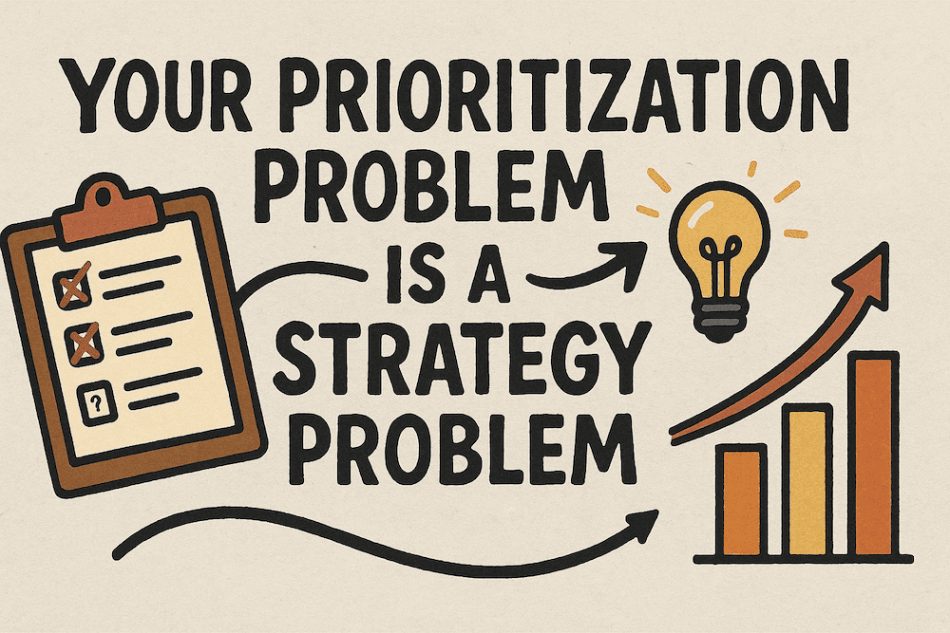Product Management
Your Prioritization Problem Is a Strategy Problem
23 Jul 2025
There’s no one-size-fits-all method for prioritizing product work. How you prioritize depends on the state of the company, what problems you’re solving, how you typically solve problems, what your customers expect, and dozens of other factors.
But still, a common question asked of product managers is, "How do you prioritize?"

The Real Problem
Companies worried about prioritizing are usually staring down a long list of Jira issues, trying to decide which to do first. There’s technical debt engineering needs to address. A competitor has introduced an innovation. Sales has a large deal that wants a new capability. The company wants to build more to support a push into enterprise deals. What should you do?
Most teams get stuck because they’re trying to optimize for everything at once. They want to satisfy the biggest customers, chase the newest opportunities, fix the most critical bugs, and build the most innovative features. This leads to analysis paralysis and constant second-guessing.
The problem isn’t that you have too many options—it’s that you don’t have a clear strategy to help you choose between them.
Strategy Makes Prioritization Easier
A strong product strategy makes a lot of priority decisions easier. It means knowing where you play, who you do it for, and how you plan on winning. What is your positioning today, what will it be in 18 months, and how do you plan on moving there? If you’re struggling with prioritization, consider whether you might have a strategy problem.
Instead of prioritizing features and issues, prioritize customer problems and outcomes. Roadmaps should be outcomes, not features. When you prioritize by comparing features, customer requests, or an issue queue, it’s easy to lose sight of the bigger picture. There’s lots of activity, but little forward progress.
Most companies have so many little fires they’re trying to fight all the time. A bunch of things that feel important at the moment and need solving right now. When you’re struggling with prioritization, this is often a symptom of trying to solve everything right now. Instead of working on what truly matters, you’re juggling small tasks as priorities.
To step out of this mindset, it’s helpful to pick one thing as a forcing function. If you could only do one thing this quarter, what would it be? Answering this question brings clarity to the chaos of all the fires.
The Components of Strategic Prioritization
Sometimes it’s hard to see what that one thing would be. It can be helpful to work backward from a vision. Look ahead at what you want the world to look like in 6-12 months. Then evaluate what needs to happen to get there. Many of these features competing for your prioritization likely aren’t part of that vision.
Another technique is to prioritize your business problems. Is activation low? Is retention falling? Are sales cycles taking too long? Aligning around the most important business need in the company is a powerful prioritization mechanism. When you know what’s important, you can find the product levers that can change this, look at all your competing priorities, and focus on the ones that will move those levers.
Establishing a set of product principles can also help guide your priorities. When you’ve decided up front how you’ll behave and what types of decisions you’ll make, you’ll avoid having the same argument about every decision. A principle of shipping early and often can help you sidestep decisions about whether something is good enough to ship. If you decide you stand for craft and customer experience, you’ll automatically prioritize ease of use and design. But if you instead have a principle of being the lowest price, you might prioritize operational improvements that reduce your costs.
These aren’t just frameworks for thinking about prioritization—they’re all components of a strong product strategy. Vision, positioning, business goals, and principles work together to create a filter for every product decision.
When Strategy Meets Reality
This all seems like common sense. It is. But what happens in most companies is you’re staring at a long feature list trying to decide which to prioritize. Engineering has tech improvements they want to do. Sales has a big contract that relies on a custom feature.
Without strategy, every decision feels equally important. With strategy, most decisions become obvious.
Good prioritization isn’t about finding the perfect order for everything. It’s about making trade-offs explicit and defensible. When you say yes to the enterprise feature, you’re saying no to the consumer improvements. When you focus on acquisition, you’re not focusing on retention. A clear strategy helps you understand which trade-offs align with your goals.
You don’t need to adhere strictly to your strategy for every decision. Having a strategy inform your priorities doesn’t put you on autopilot. Sometimes you just have to keep the ship afloat, doing routine things instead of big strategic things. Sometimes you see an interesting thing you want to experiment with. Sometimes you spot a quick win that will make customers happy. The strategy guides your prioritization—it doesn’t dictate it.
But when you’re stuck choosing between competing priorities, your strategy should be the first place you look for answers. If you find yourself constantly struggling with prioritization, the problem might not be your process—it might be that you need a clearer strategy.